Course: IP Version 4 Addressing And Subnetting Deep Dive (Part 3)
Hello and welcome, I am currently working on a video course, and I've decided to post my slides and scripts here on STEEM as I go along. I appreciate any feedback or suggestions, or if you are new to the world of computer networking, I hope you enjoy them! Here is part 3 of a multi-part series.
If you missed any sections, click one of the links below for your favorite front end:
PART 1:
https://steempeak.com/palnet/@joshman/course-ip-version-4-addressing-and-subnetting-deep-dive-part-1
https://steemit.com/palnet/@joshman/course-ip-version-4-addressing-and-subnetting-deep-dive-part-1
https://busy.org/@joshman/course-ip-version-4-addressing-and-subnetting-deep-dive-part-1
PART 2:
https://steempeak.com/palnet/@joshman/course-ip-version-4-addressing-and-subnetting-deep-dive-part-2
https://steemit.com/palnet/@joshman/course-ip-version-4-addressing-and-subnetting-deep-dive-part-2
https://busy.org/@joshman/course-ip-version-4-addressing-and-subnetting-deep-dive-part-2
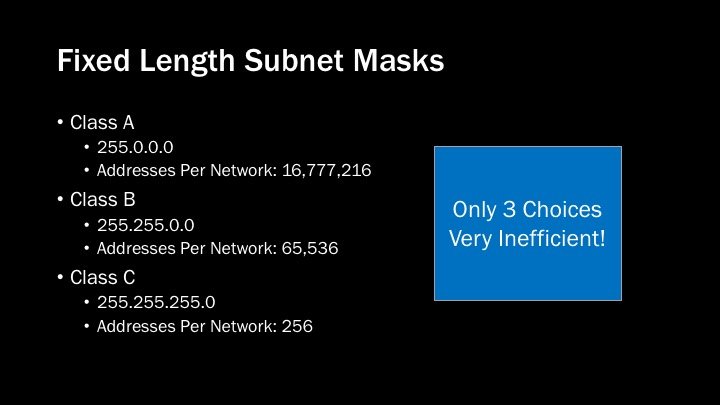
In the beginning, IP used a selection of fixed length subnet masks. These allowed a fixed number of addresses per network. Each class fell on an 8 bit bit boundary. These include:
- Class A, which has a subnet mask of 255.0.0.0, and allowed 16,777,216 addresses
- Class B, which has a subnet mask of 255.255.0.0 and allows for 65,536 addresses
- Class C, which has a subnet mask of 255.255.255.0 and allows for 256 addresses
Having only 3 choices with such a large difference between them was a very inefficient allocation model!
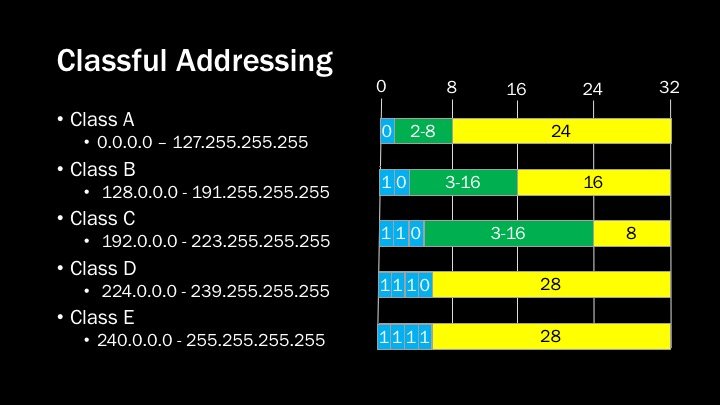
With classful addressing, you can divine the network address simply by looking at the IP address. The address classes were neatly distributed by setting the initial bits of the address indicated in blue..
- 0 for Class A
- 10 for Class B
- 110 for Class C
- 1110 for Class D
- 1111 for Class E
You are already be familiar with Class A – C, which has the network bits colored green, and the host bits colored yellow. Class D is used for multicast addressing, and Class E is considered experimental. Both are outside of the scope of this course.
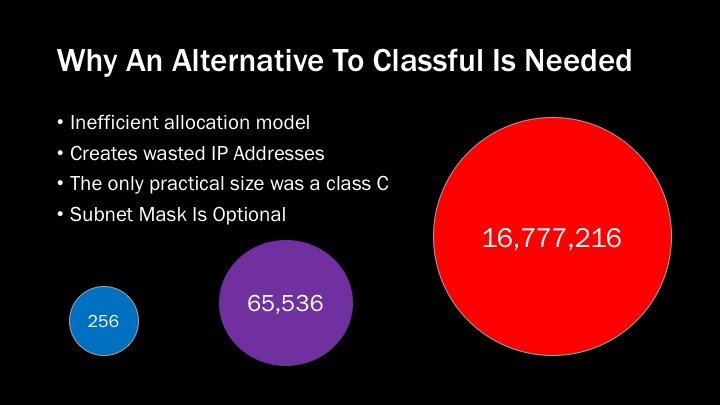
It didn’t take long to realize that the classful model would not work long term.
It was inefficient, and wasted IP addresses. The Class C was the only practical size If you had a network with 300 hosts, at 256 addresses, a Class C wouldn’t work. Your next best choice was to choose a network allowing 65,536 hosts. I can say confidently that no LAN network ever would need over 16 million addresses. With classful, the subnet mask was optional, so there was no way to break the classes up. This is why classless addressing was developed.
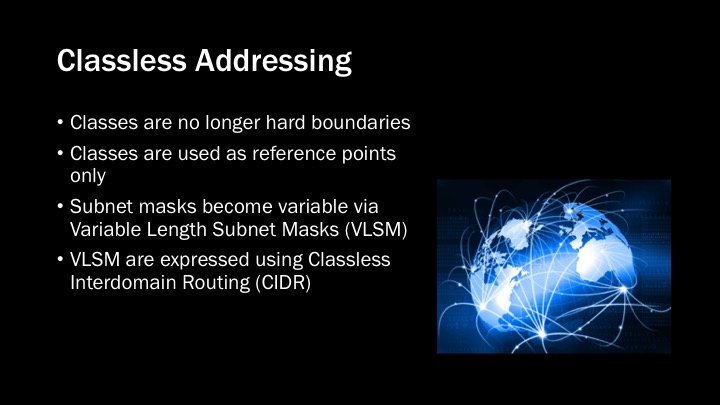
With classless addressing, we set aside classful addressing as a hard boundary to assign addresses. The classes themselves are only used as reference points only. You might still here of an organization being assigned a Class C, or a Class B, but these still exist within the modern classless system.
Classless addressing is accomplished utilizing Variable Length Subnet Masks (VLSM), and Classless Interdomain Routing (CIDR)
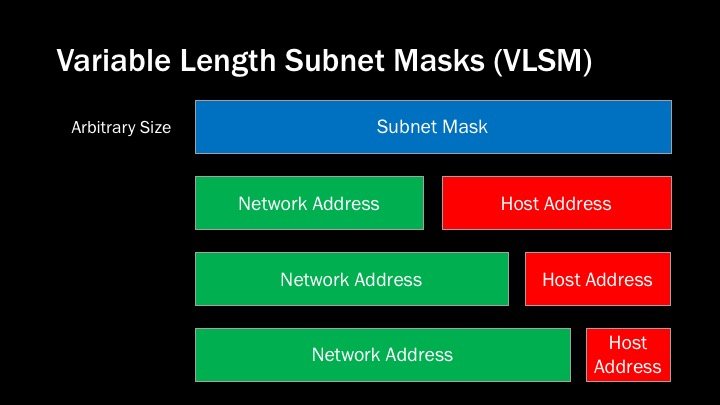
Variable length subnet masks or VLSM, removes the hard boundaries of classful address. The subnet mask can be an arbitrary size of zero to thirty two bits. Though the majority used are /16 or longer. This technique allows us to route everything from a single IP address, to the size of a Class A.
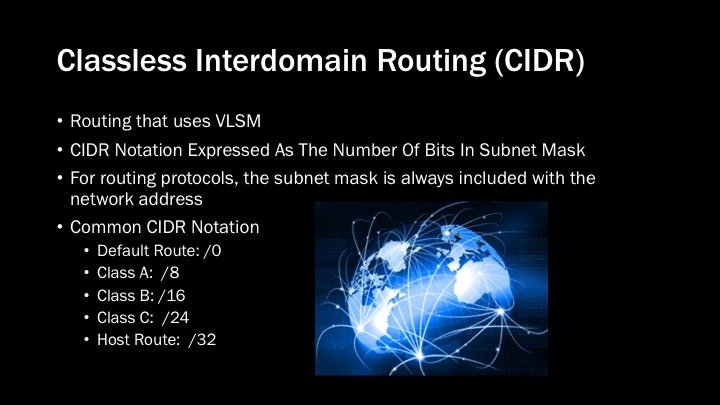
Classless Interdomain Routing(CIDR—also pronounced cider), is taking the concept of variable length subnet masks and applying it to IP routing, that is how the various network addresses get announced to one another on the internet. With CIDR, variable length subnet masks are expressed using CIDR notation. This is simply the number of bits in the subnet mask from zero to thirty two. Unlike with classful addressing, CIDR always includes the subnet mask along with the IP address when routing.
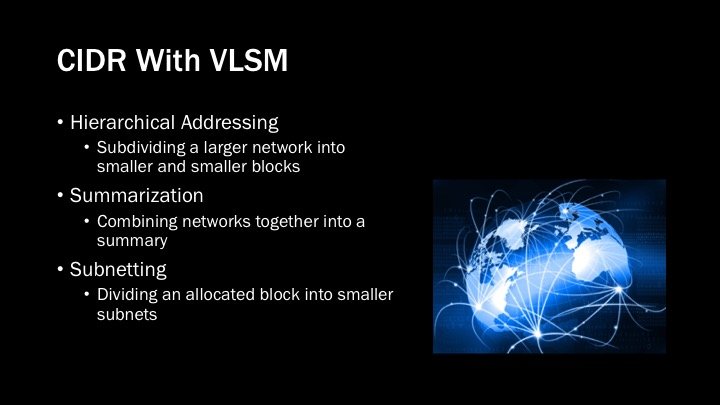
The combination of CIDR with VLSM allows a lot of flexibility in how IP addresses are allocated and advertised. It allows for hierarchical addressing, where a larger block of IPs is subdivided into smaller and smaller blocks. Summarization, which is the act of advertising the top of the address hierarchy while suppressing smaller routes. Also subnetting, which is the method by which you take a larger block of IPs and divide it up into smaller blocks. All of these concepts will be discussed in greater detail later on.
Thank you joshman! You've just received an upvote of 61% by tommyknockers!
Learn how I will upvote each and every one of your posts
Please come visit me to see my daily report detailing my current upvote power and how much I'm currently upvoting.
I think this is a cool and valid use of a Steem blog. I may not understand this topic, but I'm certain it has value, so thanks for posting it.
Im curious if you started with the first post. Maybe i need a better intro.
Posted using Partiko Android
Congratulations @joshman! You have completed the following achievement on the Steem blockchain and have been rewarded with new badge(s) :
You can view your badges on your Steem Board and compare to others on the Steem Ranking
If you no longer want to receive notifications, reply to this comment with the word
STOPTo support your work, I also upvoted your post!
Thanks for the interesting series. I think it is useful information for anyone who wants to learn about IPV4 networking. I included a link to all three posts in the series in my recent article, Curating the Internet: Science and technology micro-summaries for July 23, 2019, and applied a beneficiary setting to direct 5% of rewards to you.
Thanks, much appreciated!